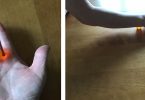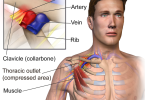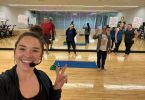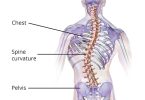How many of us are dealing with numbness and tingling in our hands? I know it’s a lot because I see many clients with these exact complaints. Repetitive use, whether it’s computer use, or other repetitive motions, will set you up for these issues if you are not using your body effectively.
The reason why we have the numbness and tingling is because of compression of the nerves that supply our arms and hands. This group of nerves is called the brachial plexus. See the photo and notice how this nerve bundle runs under the scalene muscle in the neck, collar bone and the pectoralis minor muscle. All of these muscles can become very tight when we sit poorly with our head forward and shoulders rounded for many hours at a time and or work repetitive tasks with little body awareness.
Without even realizing it, we use way too much energy when typing an email, chopping vegetables, scrubbing the dishes or most any other task. Here’s an exercise to try …
Bring out your vacuum and get ready to do a bit of cleaning. Grasp the handle as you normally would and work for a bit and see if you can sense the tension in your arms and neck and anywhere else in your body as you work. Now rest a minute and then change your grasp on the handle by thinking about how the handle feels on your palm and fingers and then think about the handle being glued to your palm.
You may feel your grip has changed; it is softer and maybe there is less tension in your body overall. When you feel what you are touching, your grip loosens and therefore your arms, shoulders and neck have less tension and do not work as hard. Try this with the steering wheel of the car or the chef’s knife when chopping vegetables.
Now let’s try another exercise. This one helps to activate the area under the shoulder blade and around the spine, taking some of the work away from the neck and collarbone area …
Grasp the steering wheel at 10 and 2 o’clock how you normally would. Most people will grasp with the thumb and first two fingers. Grip a little tighter and pay attention to where you feel this in your body. You should feel activity in your neck and collarbones. Now, grasp with emphasis on your last two fingers. You should feel activity under your shoulder blades. Go back and forth between the thumb and first two fingers and then grasp with the last two fingers emphasized.
The tighter grip is for the purpose of this exercise only. Now go back to the softer feel of the pervious exercise where you are feeling the wheel with your palm and your grip softens and then go back and forth between the two grips. Do you see where you do not have to grip tightly to get the work done? Do you see why using the two last fingers allows the front of the shoulder to soften? You can try this with anything else you do to decrease tension in tissues around the brachial plexus nerves.
By Gwen MacLean for Living Balance Clinic







